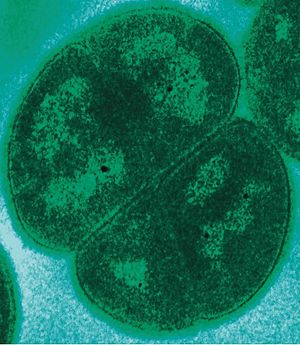Deinococcus radiodurans facts for kids
Quick facts for kids Deinococcus radiodurans |
|
|---|---|
 |
|
| A tetrad of D. radiodurans | |
| Scientific classification | |
| Kingdom: | |
| Phylum: | |
| Order: |
Deinococcales
|
| Genus: |
Deinococcus
|
| Species: |
D. radiodurans
|
| Binomial name | |
| Deinococcus radiodurans Brooks & Murray, 1981
|
|
Deinococcus radiodurans is a tiny living thing, a type of bacterium, that is very special. It's known for being incredibly tough! This bacterium is gram-positive (which means it has a certain kind of cell wall), doesn't move on its own (it's nonmotile), and has a reddish color. It was first found in 1956 in canned meat that had been treated with radiation to kill germs. People thought the meat was clean, but this amazing bacterium survived!
D. radiodurans has special ways to fix its own DNA if it gets damaged. It can also get rid of damaged DNA parts and has extra copies of its important genes. This helps it recover from being very dry (called desiccation) or from not having enough food (called starvation). It can handle very high levels of radiation, like gamma radiation, much better than almost any other living thing. In fact, it is known as the most radiation-resistant organism on Earth! An enzyme called thioredoxin reductase helps its cells fix broken DNA strands.
Scientists have found that D. radiodurans has a gene that makes a protein very similar to the RecD enzyme found in another common bacterium, E. coli. This discovery suggests that this RecD-like protein is a very important part of how D. radiodurans fixes its DNA.
Contents
Super Bacteria: How D. radiodurans Survives Radiation
Deinococcus radiodurans is famous for its amazing ability to survive things that would kill most other living things. It can live through extreme cold, dehydration, vacuum, and even acid. But its most impressive superpower is its resistance to radiation.
Why is D. radiodurans so Tough?
This bacterium has several special tricks up its sleeve.
- DNA Repair: Its main secret is its incredible ability to fix its own DNA. DNA is like the instruction manual for a cell. Radiation can break these instructions into many pieces. D. radiodurans has a super-efficient repair crew that can put all the pieces back together perfectly.
- Many Copies of DNA: Unlike most bacteria that have one or two copies of their DNA, D. radiodurans can have four to ten copies. If one copy gets damaged, it has many backups!
- Special Proteins: It has unique proteins and enzymes that protect its DNA and help with repairs. One important enzyme is called thioredoxin reductase, which helps fix broken DNA strands.
The Deinococcus Family
The group of bacteria that Deinococcus radiodurans belongs to is called the Deinococcus genus. There are 47 different species in this genus. All of them share the ability to resist radiation. D. radiodurans was the first one discovered, and it's the one scientists have studied the most.
Future Possibilities
Because D. radiodurans is so good at surviving radiation, scientists are very interested in it. They wonder if they could use its special abilities to help other things.
Making Other Bacteria Stronger
Some researchers are trying to make other bacteria as radiation-resistant as D. radiodurans. For example, a team in China is trying to put a special protein from D. radiodurans into E. coli. The biggest challenge is making sure this protein works well and stays active in the new bacterium. If they succeed, it could open doors for many new uses.
Potential Uses
Imagine if we could make bacteria that could clean up radioactive waste! Or perhaps create crops that can grow in harsh, irradiated environments. The unique abilities of D. radiodurans could be very useful in the future for cleaning up pollution or even for space travel.
See also
 In Spanish: Deinococcus radiodurans para niños
In Spanish: Deinococcus radiodurans para niños

